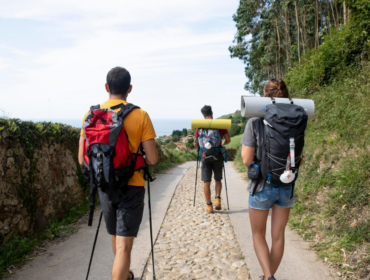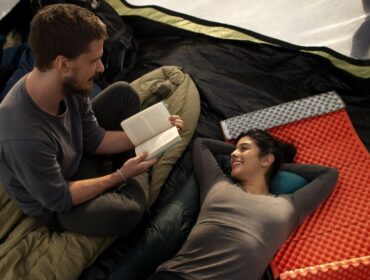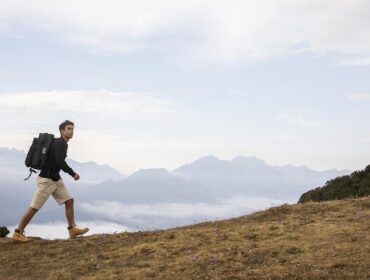While the towering volcano is bound to captivate you at every turn, there’s plenty else that will dazzle you as you wander throughout Mount Rainier National Park. Mount Rainier offers so many diverse hiking opportunities, and the views go on and on when you hike up from either visitor center. Let’s get into your guide to the park, so you can start planning your next trip.

What to Know Before You Go
Sitting two hours south of Seattle — and even less from the airport — it’s one of the most accessible parks to visit in the country because of its proximity to Sea-Tac International Airport, which has over two million people visit each year. Although, keep in mind that most of those people are squeezed into the summer months, making visiting potentially frustrating on weekends or holidays.
The park is split into two main parts. The first part is at the Paradise Visitor Center, which sits on the south side of Mount Rainier and provides access to hikes directly on the mountain. You can get here from multiple directions, but the quickest from Seattle/Tahoma is to drive on the park’s western side and come in from the southwest.
The second area, Sunset Visitor Center, is on the northeastern side and allows for stunning hiking views of the Cascades to the north and Mountain Rainer to the south. The adventures here are endless, but you won’t get to hike on the big mountain.
Another point to keep in mind is that your trail could have snow on it if you’re visiting before the middle of July. I would recommend bringing hiking poles and microspikes as a precaution to provide better stability.
Check out this Gear List for Winter Hiking for more inspiration.
Sleeping
Hotels
For lodging, nearly all of the hotels are on the southwestern side of the park near Ashford, which is the closest city outside of the park’s southwestern entrance. Ashford has plenty of lodging, but it will fill up during the busy season. Inside the park, there are two hotels to choose from: National Park Inn and Paradise Inn. If those are booked, or you’re looking to stay on the southeast side, the town of Packwood will have options for you and the family.
Car Camping
Keep in mind that campgrounds don’t open until late May throughout the park. But, during the summer, these are some of the best campgrounds around. Cougar Rock is the best if you’re looking to spend time near Paradise. These, as you can imagine, fill up quickly. This is especially true on the weekends, so plan before you go. On the other hand, if you want to spend most of your time near Sunset Visitor Center, White River Campground is your best bet.
- Cougar Rock – 173 sites, SW section of the park, $20 per site
- Ohanapecosh – 188 sites, SE section of the park, $20 per site
- White River – 112 sites, NE section of the park, $20 per site
- Mowich Lake – 13 tent sites for walk-in use, no fee
There are also a handful of National Forest campgrounds outside the park that will be slightly less crowded. Still, you won’t want to delay your reservations.
If you’re new to this, check out What to Know When Car Camping.
Backpacking
The Wonderland Trail is one of the preeminent backpacking trails in the United States. The entire trail — 96 miles and 25,000 feet of elevation gain in all — circumnavigates Mount Rainier and offers an incredible array of views, challenges, and life-changing moments. Trekking the entire trail is a 10–12-day affair. Many people will break it up and do smaller segments that work better with their schedules.

Hiking
Unless you’re going to Mount Rainier only to look at it, you’re there to hike. And hike you will! With hundreds of miles of trails throughout the park, there’s a trail for every skill level. For me, I enjoyed the hikes from the Sunset Visitor Center. It’s separate from Mount Rainier, which allows you more room to enjoy and put the massive mountain into perspective. Additionally, the hiking hub sits over 7,000 feet which means you’re pretty high up. You’ll quickly notice the views of the Cascades around you are stunning.
Easy Hikes
- Myrtle Falls – 1 mile, 150 feet elevation gain
- Bench and Snow Lakes – 2.2 miles, 450 feet elevation gain
Medium Hikes
- Panorama Point – 4 miles, 1,200 feet elevation gain
- Dege Peak – 3.1 miles, 800 feet elevation gain
- Fremont Lookout – 5.7 miles, 1,100 feet elevation gain
- Green Lake Trail – 9 miles, 1,500 feet elevation gain
Hard Hikes
- Camp Muir – 8.5 miles, 4,600 feet elevation gain
- Tolmie Peak – 5.6 miles, 1,500 feet elevation gain
- Burroughs Mountain Loop – 9.5 miles, 2,500 feet elevation gain
- Skyline Loop – 6 miles, 1,800 feet elevation gain
Summit of Mount Rainier
One of the draws of Mount Rainier National Park is summiting Mount Rainier. However, this isn’t just an ordinary mountain to summit. It takes more diligence and care to hike up with glaciers and crevasses. Due to this potentially dangerous snow travel, only experienced hikers should go without a guide. The hike, overall, is 15 miles round trip and close to 9,000 feet of elevation gain.
For those curious, the summit push is usually a two-day affair. The first day is hiking to Camp Muir, also known as Mount Rainier Basecamp. There, you’ll set up tents and spend the night. Then, a midnight wake-up call will allow you to summit around sunrise and complete the entire hike down that morning.

Six Great Places to Photograph
Many people — myself included — visit these places to soak up the beautiful landscapes and snag incredible photos. There’s nothing wrong with a dual-purpose trip. Below are six of my favorite places to shoot in and around Mt. Rainier National Park. I recommend at least a 70-200mm lens to best capture the layers, but a 400mm or greater will blow your audience away.
- Dege Peak – This is a mild 3-mile round trip hike that overlooks the visitor center. You’ll have incredible views of Rainier and the Central Cascades to the north.
- Tipsoo Lake – This one is right off the side of the road coming into the park from the east. Tipsoo is a perfect place for sunrise. Try to get a reflection of Rainier in the water.
- Reflection Lake – This is another easy-to-reach photography destination. About 5 minutes from the Paradise Visitor Center, Reflection Lake offers crazy views of Rainier in the water’s reflection. The bugs can be nasty in the summer, so wear long sleeves and have a bug net on hand.
- Fremont Lookout – About a seven-mile hike from the Sunset Visitor Center, you’ll reach Fremont Lookout. If you see inversion conditions, this is the place to be.
- High Rock Lookout – The only place outside of the park boundaries on this list, High Rock Lookout, is gorgeous. With views from the south looking at Rainier, you won’t be disappointed with your photos.
- Burroughs Mountain – Burroughs Mountain Trail is the closest to Mount Rainier from the Sunset side. There are technically three mountains to visit. I recommend visiting the second one at a minimum. You’ll be treated to incredible views all around.
Best Time to Visit
The best time is the summer — hands down. Summertime in the PNW offers the most gorgeous views and conditions in the nation. With long summer nights that last well past 9 pm and temperatures in the 70s or 80s (F), it’s truly an oasis of perfection. However, this isn’t a secret, so most visit June through September.
Arriving early and staying late or visiting during the week will help make the trip a more memorable experience and provide you with a more natural experience.
Wildlife
The wildlife in the park is numerous so keep an eye out when you’re driving and hiking. The most likely animals you’ll see are deer and marmots. Additionally, mountain goats will be easy to spot once the snow melts but shouldn’t come too close to humans. I saw them briefly during the summer months. As with all wilderness locations, being bear safe is vital. Make sure to store your food and gear in the appropriate places, or you might find yourself in an uncomfortable predicament. Other animals you might spot but are less likely are Red Foxes, Mountain Lions, Bobcats, Elk, and Owls.
For more on staying safe and prepared, read How to Protect From Bears While Camping.
Article and Photos by Alec Sills-Trausch
Alec is a photographer, writer, and avid hiker who enjoys pushing the limits to find incredible destinations. He hopes through his work to inspire others to get outside and to respect planet earth so future generations can enjoy it just the same. He’s also a cancer survivor. And, he hopes to use his voice to show that you can have a wonderful life after the treatment.




